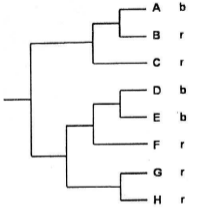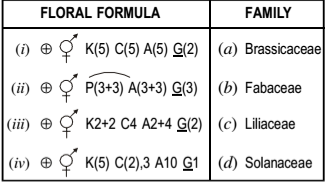 Multiple Choice Questions
Multiple Choice QuestionsWhich of the following groups represents SAR clade of protists?
Euglenozoans, Red algae, Parabasilids
Brown algae, Forams, Radiolarians
Slime moulds, Entamoebas, Diplomonads
Charophyes, Choanoflagellates, Tubulinids
Following table shows a list of clades and plant:
| Clades | Plant |
| (a) Basal angiosperms | (i) Black pepper |
| (b) Magnolids | (ii) Orchid |
| (c) Monocots | (iii) Star anise |
| (d) Eudicots | (iv) Strawberry |
Which one of the following is correct match for the above?
| (a) | (b) | (c) | (d) |
| (iii) | (iv) | (ii) | (i) |
| (a) | (b) | (c) | (d) |
| (i) | (i) | (iii) | (iv |
| (a) | (b) | (c) | (d) |
| (ii) | (iv) | (iii) | (i) |
| (a) | (b) | (c) | (d) |
| (iii) | (i) | (ii) | (iv) |
The phylogenetics tree below shows evolutionary relationships among 8 species. Males of these species are either blue (b) or red (r) in color, the color being indicated next to each species name.

Based on the principle of parismony, which of the following statements best represents the evolution of male body color in this set or species?
The most recent common ancestor of all 8 species was blue; red evolved independently 5 times.
The most recent common ancestor of all 8 species was blue; red evolved independently 4 times.
The most recent common ancestor of all 8 species was red; blue evolved independently 3 times.
The most recent common ancestor of all 8 species was red; blue evolved independently 2 times.
D.
The most recent common ancestor of all 8 species was red; blue evolved independently 2 times.
According to the principle of maximum parisony, we should first investigate the simple explanation that is consistent with the facts. In the case of tree based on morphology, the most parisonious tree requires the fewest evoluntionary events, as measured by the origin of shared derived morphological characters. For phylongenetics based on DNA, the most parsimonious tree requires the fewest base changes. here only two changes in lineage of A and common lineage of B and D for development of blue color from the ancestral red can explain the tree.
A list of floral formulae and plant families are given in the following table:

Which of the following option most appropriately matches given plant families with their representative floral formulae?
(i)-d, (ii)-(b), (iii)-(a), (iv)-(c)
(i)-(d), (ii)-(c), (iii)-(a), (iv)-(b)
(i)-(d), (ii)-(c), (iii)-(b), (iv)-(a)
(i)-(a), (ii)-(c), (iii)-(b), (iv)-(d)
Which of the following plastid coding region(s) have been recommended as a core barcode by Plant Working Group of the consortium for the Barcode of Life?
CO1 and rbcL
rbcL and matK
CO1 and matK
rbcL only
